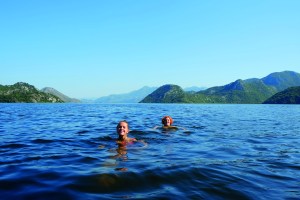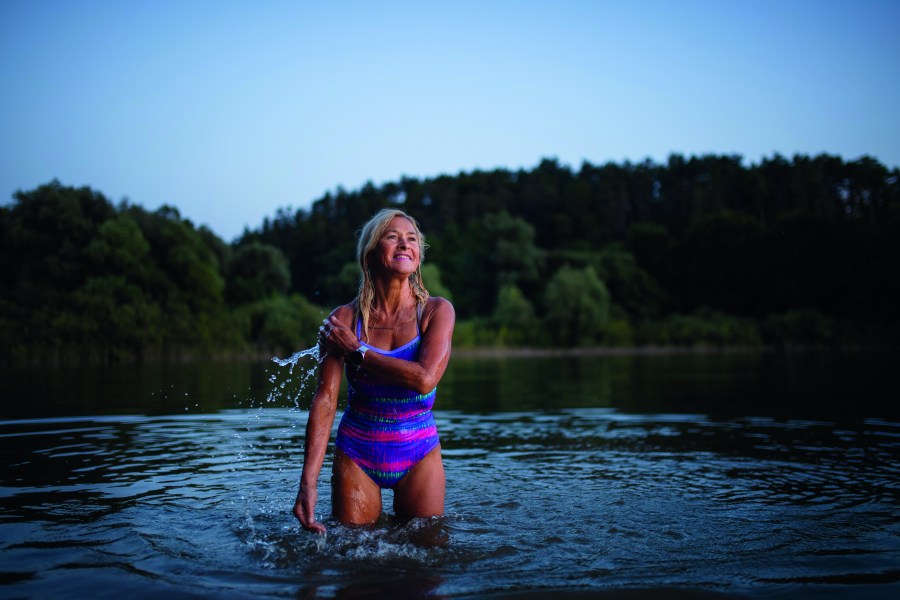If you haven’t tried cold-water swimming, now could be the time to wet your feet. Your mental health will thank you.
From pro athletes following the Wim Hof method to mid-life women at the local beach, we can’t get enough of cold-water immersion, with claimed effects including pain reduction, fat loss and lower cardiovascular risk. There’s anecdotal evidence for mental health benefits, too, but so far rigorous studies are few and far between – a fact that led Dr Heather Massey, senior lecturer in sport, health and exercise science at the University of Portsmouth, to investigate the feasibility of conducting a random control trial into the effects of outdoor swimming in adults with depression. Massey and her team are currently analysing the data from that investigation – OUTdoor Swimming as nature-based Intervention for DEpression (OUTSIDE) – but Massey tells Women’s Fitness they showed enough promise for further research to be undertaken this spring/summer and next.*
Cold comfort
Water temperatures in the UK range from 15-20oC in the summer months to a biting 0-7oC in winter. Put those figures against
a healthy body temperature of 37 degrees Celsius, and it makes sense that any outdoor dip in the UK is considered cold-water swimming. But what exactly happens to your body when you take the plunge and how does it affect you mental wellbeing? ‘At the biochemical level, whole-body exposure to cold triggers a release of neurotransmitters such as serotonin, cortisol, dopamine, norepinephrine and beta-endorphin, which play a crucial role in emotional regulation, stress regulation and reward processing,’ explains Massey. ‘Deficits in these neurotransmitters have been reported as critical factors in developing psychiatric disorders such as depression, anxiety and emotional disturbances.’
When it comes to understanding why a cold plunge supports mental wellbeing, the reasons haven’t yet been proven and more research is needed. Some possibilities include ‘physiological (hormone and inflammatory responses, including cross adaptation), psychological (distraction, placebo, a challenge) and social reasons (meeting new people with similar interests)’, says Massey.
Your vagus nerve could also play a part. ‘The vagus nerve has several branches, and one has nerve fibres located around the eyes and face. These nerves are parasympathetic, act to reduce heart rate and have a general calming effect. There is some evidence that exposing the face to cold water does reduce stress responses,’ she adds.

Testing the water
If you haven’t tried cold-water swimming before, it’s a good idea to start around the end of May or during June when the water in the UK is warmer, advises Kate Rew, author of The Outdoor Swimmers’ Handbook (Rider, £22) and founder of the Outdoor Swimming Society (outdoorswimmingsociety.com).
Plunging your body into cold water can be a shock to your system, so find the way that works best for you. Some people prefer to quickly submerge themselves up to the shoulders and swim fast until their body adapts to the cooler temperature. ‘You could also dab your pulse points and back of neck with water and maybe bob up and down a bit before setting off,’ suggests Rew. ‘What will happen is an involuntary gasp known as cold-water shock, so you don’t want to be underwater when this happens.’ If you want to feel completely safe, make sure your feet are still on the bottom until the sensation passes. ‘Focus on the exhale, and the inhale will come,’ she adds. ‘It often takes about a minute to start breathing normally.’
So how often should you take to the waters to boost your mood, and how long should you stay in? ‘We don’t know the answer to this,’ says Massey. ‘We think shorter immersions are those that provide the mood enhancements, possibly due to the cold shock response. Overstaying in cold water results in hypothermia, and we see more negative mood and people’s behaviour become more insular. The best guess at the moment is shorter immersions and “warmer” cold water.’ Perhaps the most useful advice for now is to monitor your responses, and do what produces the best effect for you.
What you do once out of the water is important as well – as you’ll have stopped exercising, you’ll feel the cold more. Of course, you’ll need to dry off and put warm clothes on as soon as possible but avoid the temptation for a quick fix. ‘Don’t have a warm shower or bath,’ warns Rew. ‘They’ll make “afterdrop” – the sensation of chilling further once you’re out of the water – worse. Warm up from the inside with a hot drink and some gentle movement.’
Best long sleeve swimsuits for wild swimming UK
Safety first
Once you’ve ensured you’re being responsible in relation to water temperatures, your safety is related to your strength as a swimmer, believes Rew. It’s best to swim with a buddy, and let people know where you’re going. If you’re new to open-water swimming, start with lakes, river pools and calm seas where you can put your feet down. You might want to do a recce of your chosen spot in advance or ask local wild swimmers about any risks.
It’s important to pace yourself too, regardless of your swimming ability. ‘You’ll be at your coldest 10 minutes after you get in, so don’t push it at first. Start small and increase your duration in the water when you’ve worked out what is comfortable for you,’ Rew advises. A bright swimming hat and/or tow float is a good idea if you’re swimming in areas with boat traffic or strong currents, and you might appreciate wearing a hat, neoprene gloves and booties in the winter. A cosy changing robe on the shore/bank will be a welcome sight when you’re emerging from a cold-water swim, but if you’re feeling the chill, don’t worry, the feel-good factor will last long after the goosebumps fade!







